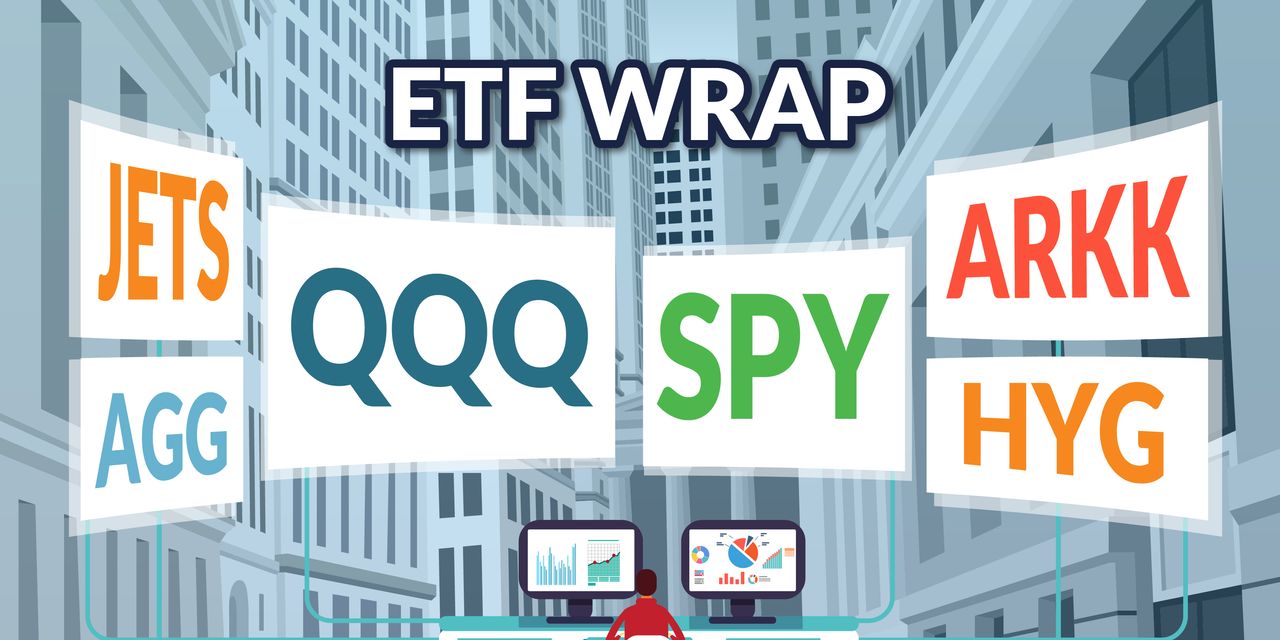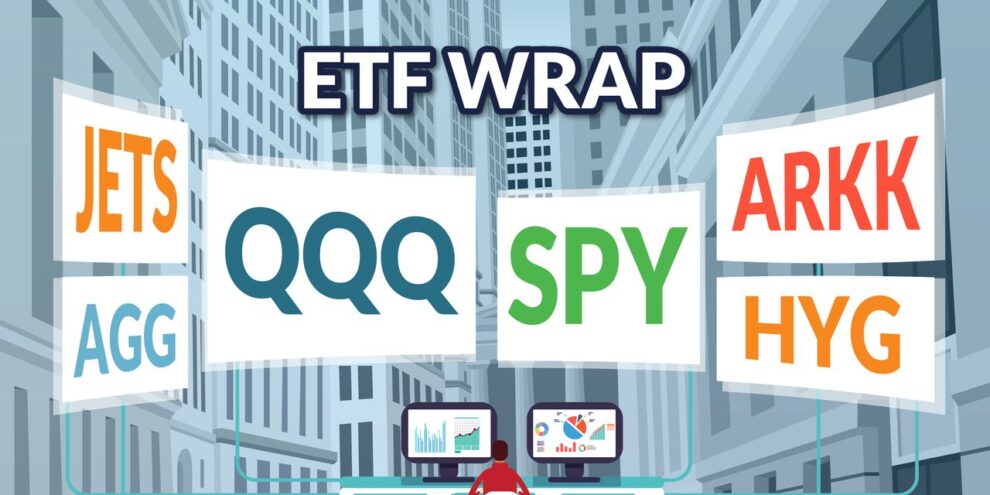
Happy New Year! It’s the eve before the eve of the end of 2021. In other words, this is the last edition of ETF Wrap of the year before we kick it off again. Short of a crystal ball, we’re going to offer up some insights from the folks at Astoria Advisors on what to buy next year.
We’ll keep things short and sweet.
And as per usual, send tips, or feedback, and find me on Twitter at @mdecambre or LinkedIn, to tell me what we need to cover, or share your 2022 outlooks for the industry. We’ll try to post a few of those as we get them.
Most important, sign up here for ETF Wrap sent fresh to your inbox weekly (make that a New Year’s resolution).
Check out: What is an ETF? We’ll explain.
The good
| Top 5 gainers of the past week | %Performance |
| U.S. Oil Fund LP USO, -1.29% | 6.0 |
| iShares MSCI Sweden ETF EWD, +0.13% | 4.9 |
| AdvisorShares Pure US Cannabis ETF MSOS, -0.31% | 4.6 |
| Invesco Dynamic Semiconductors ETF PSI, +0.47% | 4.5 |
| Consumer Discretionary Select SPDR Fund XLY, +0.13% | 4.3 |
| Source: FactSet, through Wednesday, Dec. 29, excluding ETNs and leveraged products. Includes NYSE, Nasdaq and Cboe traded ETFs of $500 million or greater |
…and the bad
| Top 5 decliners of the past week | %Performance |
| ARK Genomic Revolution ETF ARKG, -0.37% | -6.2 |
| First Trust Global Tactical Commodity Strategy Fund FTGC, -0.00% | -4.5 |
| Vanguard Total International Bond ETF BNDX, +0.01% | -3.0 |
| SPDR S&P Biotech ETF XBI, -0.56% | -2.9 |
| ARK Innovation ETF ARKK, -0.94% | -2.8 |
| Source: FactSet |
ETFs for 2022
Yield, yields and income. That would appear to be the major takeaway from our discussions with John Davi, founder of portfolio strategist Astoria Advisors. We reviewed some of Astoria’s 2021 calls and Davi offered up some ideas for next year that are worth a look, given the times.
Davi’s calls shouldn’t be taken as investment advice but it is always interesting to garner some perspective based on where some of the pros are putting their money.
Net, net, net
- Davi says Netlease Corporation Real Estate ETF NETL, +0.40% is a good bet because real-estate investment trusts focused on net leases offer predictable sources of income. A net lease agreement is a long-term agreement in which the lessee is responsible for most of or all the property expenses, Davi explains. Real estate is generally viewed as a good inflation bet. NETL, which launched back in 2019, was up 22% in 2021 and carries an expense ratio of 0.60%. That translates to annual expenses of $6 for every $1,000 invested.
Paying dividends
- The next pick (actually a pair) is another sober selection that emphasizes consistency over fanfare. SPDR S&P Dividend ETF SDY, +0.27% and SPDR Portfolio S&P 500 High Dividend ETF SPYD, +0.24% offering consistently high-yielding, low-cost ETFs for average folks in times where stomach-churning volatility may be too much to handle. “SDY and SPYD track the returns of the S&P High Yield Dividend Aristocrats Index and the S&P 500 High Dividend Index, respectively, while providing a healthy dividend in the meantime,” writes Davi. SPYD has an expense ratio of 0.07%, has assets of over $5 billion and was up 28% with a 3.7% dividend, at last check Thursday midday; while SDY charges 0.35%, manages over $20 billion and gained 22% in 2021 thus far, while touting a 2.64% yield.
Covering calls
- Global X NASDAQ 100 Covered Call ETF QYLD, -0.09% is a more sophisticated selection, which Davi says makes sense in a market where lofty stock valuations and volatility are expected. Covered-call funds sell “call” options, which give the owner the right but not the obligation to purchase a stock at a set price (the strike price) within a certain period. The term “covered” refers to the fact that the fund owns the underlying stocks that the options represent. The idea here is that the investment acts as a sort of insurance, particularly during volatile markets, where the funds collect premiums on the calls they sell, which in turn is distributed to shareholders. The call income limits the downside for the investment and investors can benefit if the target stocks rise in value. QYLD traded down 2.4% so far in 2021, but it has a distribution yield of 11.4% with an expense ratio of 0.60%.
- It’s worth mentioning the Eaton Vance Tax-Managed Buy-Write Income Fund ETB, -0.41% offers a similar strategy and is up 15% in the year to date, though it is a closed-end fund and is more expensive at over 1%. It does offer a distribution of about 8%.
Alternative loans
- Davi recommends SPDR Blackstone Senior Loan ETF SRLN, +0.13% and VanEck High Yield Muni ETF HYD, +0.01% because there is uncertainty about how quickly the Federal Reserve will act to lift interest rates in its combat against pricing pressures.
- “At yields of 4.5% and 3.6%, respectively, SRLN and HYD have attractive income characteristics,” Davi wrote. SRLN, which kicked off in 2013, has an expense ratio of 0.7% and offers exposure to noninvestment credit floating-rate corporate debt of U.S. and international companies. Meanwhile, HYD carries an expense of 0.35% and tracks a market-weighted index of high-yielding municipal bonds. It has been around since 2009.
And one more thing
- Astoria is joining with AXS Investments to kick off what Davi describes as the first-ever “multi-asset, global ETF dedicated to protect and profit from rising inflation.” The AXS Astoria Inflation Sensitive ETF includes a mix of inflation-sensitive stocks, ETFs, including commodities, Treasury inflation-protected securities, or TIPS, cyclical stocks such as industrials, materials, banks, home builders and more. As Davi puts it, “TIPS while gathering significant assets year to date, simply aren’t enough to hedge inflation risk for 60/40 portfolios,” referring to the traditional model portfolio mix of stocks and bonds. The fund will trade on Intercontinental Exhange-owned New York Stock Exchange’s NYSE Arca platform and will carry an expense ratio of 0.71%. Cyclical stocks will make up the bulk of the ETF.
How’s the anti-Cathie Wood doing?
Matthew Tuttle is a bit surprised that an anti-Cathie Wood ETF that was launched back in mid November hasn’t drawn more inflows. The star investor’s flagship ARK Innovation ETF ARKK is down for the year, even as the broader market has enjoyed new records for the S&P 500 index SPX, +0.03%.
“I am surprised,” Tuttle told MarketWatch in a Tuesday interview.










